Development of Adaptive Model and Occupant Behavior Model in Four Office Buildings in Nagasaki, Japan
Abstract
:1. Introduction
2. Methodology
2.1. Survey Method
2.1.1. Survey Location, Climate, and Survey Period
2.1.2. Characteristics of Target Buildings
2.1.3. Method of Indoor Thermal Environment Measurement and Questionnaire Survey
2.2. Analysis Method
2.3. Calculation Method for the Comfort Temperature
2.3.1. Regression Method
2.3.2. Griffiths’ Method
2.4. Calculation Method for the Running Mean Outdoor Temperature
2.5. Estimation of the Occupant Behaviors
3. Results and Discussion
3.1. Thermal Sensation Vote
3.2. Overall Comfort Votes
3.3. Comfort Temperature
3.3.1. Comfort Temperature Based on Mode
3.3.2. Comfort Temperature Based on Gender
3.3.3. Comfort Temperature Based on Constitution
3.3.4. Comfort Temperature Based on Age
3.3.5. Comfort Temperature Fluctuation in the FR Mode
3.4. Relationship between Indoor Comfort and Outdoor Air Temperatures
3.5. Occupant Behavior
3.5.1. Occupant Behaviors Adopted to Experience Coolness and Warmth
3.5.2. Clothing Insulation
3.5.3. Heating and Cooling Use
3.5.4. Window Opening Behavior and Fan Use
4. Overall Discussion
5. Conclusions
- Most occupants tended to find indoor environments comfortable. Analysis of different modes revealed that the mean comfort temperatures calculated using Griffiths’ method ranged from 23.2 to 25.9 °C. Furthermore, there were regional differences in the seasonal comfort temperature fluctuations in offices between the Kanto region and Nagasaki City in the FR mode.
- There were significant differences in the comfort temperature among modes, but a significant difference was found only in the CL mode when comparisons were conducted based on gender and constitution. Although there were significant gender differences in thermal and comfort sensations, the mean comfort temperatures calculated for females were significantly higher than those for males by 0.4 °C only in the CL mode.
- The results of the environmental adjustment behaviors indicated that females tend to execute more behaviors to experience warmth compared with males. The mean level of clothing insulation for males was significantly higher compared with that of females in the HT mode, although the mean clothing insulation showed no significant gender differences in the FR and CL modes.
- It was verified that the comfort temperature in any mode varied in conjunction with the outdoor air temperature in office buildings. However, the results indicate that there may be regional differences in the regression coefficients within Japan.
- An adaptive model was developed for the office buildings in Nagasaki City to predict the indoor comfort temperature from the outdoor air temperature. This model contributes to the predicting the comfort temperature in other cities located in areas with warm climates. A model corresponding to the local climate could be constructed for the adaptive building design.
- Using a logistic regression analysis, we clarified how the heating/cooling use, window opening behavior, and fan use relate to the outdoor air temperature. The values of the logistic coefficients were in the order of heating/cooling usage, fan usage, and window opening behavior. It was confirmed that the heating/cooling usages were highly related to the outdoor air temperature; correspondingly, the logistic regression equation could be applied to predict the heating and cooling usage proportions based on the outdoor air temperature. It was confirmed that fan use is moderately related to the outdoor air temperature and that the window opening behavior in the FR mode is only weakly related to the outdoor air temperature; correspondingly, further analysis is needed to improve the window opening and fan use models by collecting more data.
6. Research Limitations
- This field study was conducted based on monthly visits. Therefore, it will be necessary to devise a new survey method, such as combinating the existing one with a daily survey.
- In this study, we selected four office buildings as the surveyed offices (with a high frequency of opening windows), all of which were MM. It is necessary to investigate the HVAC-mode office buildings and compare them with the MM office buildings employed in this study.
- As the survey was conducted during the COVID-19 pandemic, it was relatively common to observe offices with windows open for ventilation during periods when air conditioning was on, even though mechanical ventilation equipment was installed. This phenomenon did not occur before the COVID-19 pandemic, and it is unclear whether the use of air conditioning practices will be restored to those used during the pre-pandemic period.
- To predict the window opening proportion based on the outdoor air temperature, it is necessary to improve the prediction accuracy by collecting more data from the office buildings.
Author Contributions
Funding
Data Availability Statement
Acknowledgments
Conflicts of Interest
Appendix A
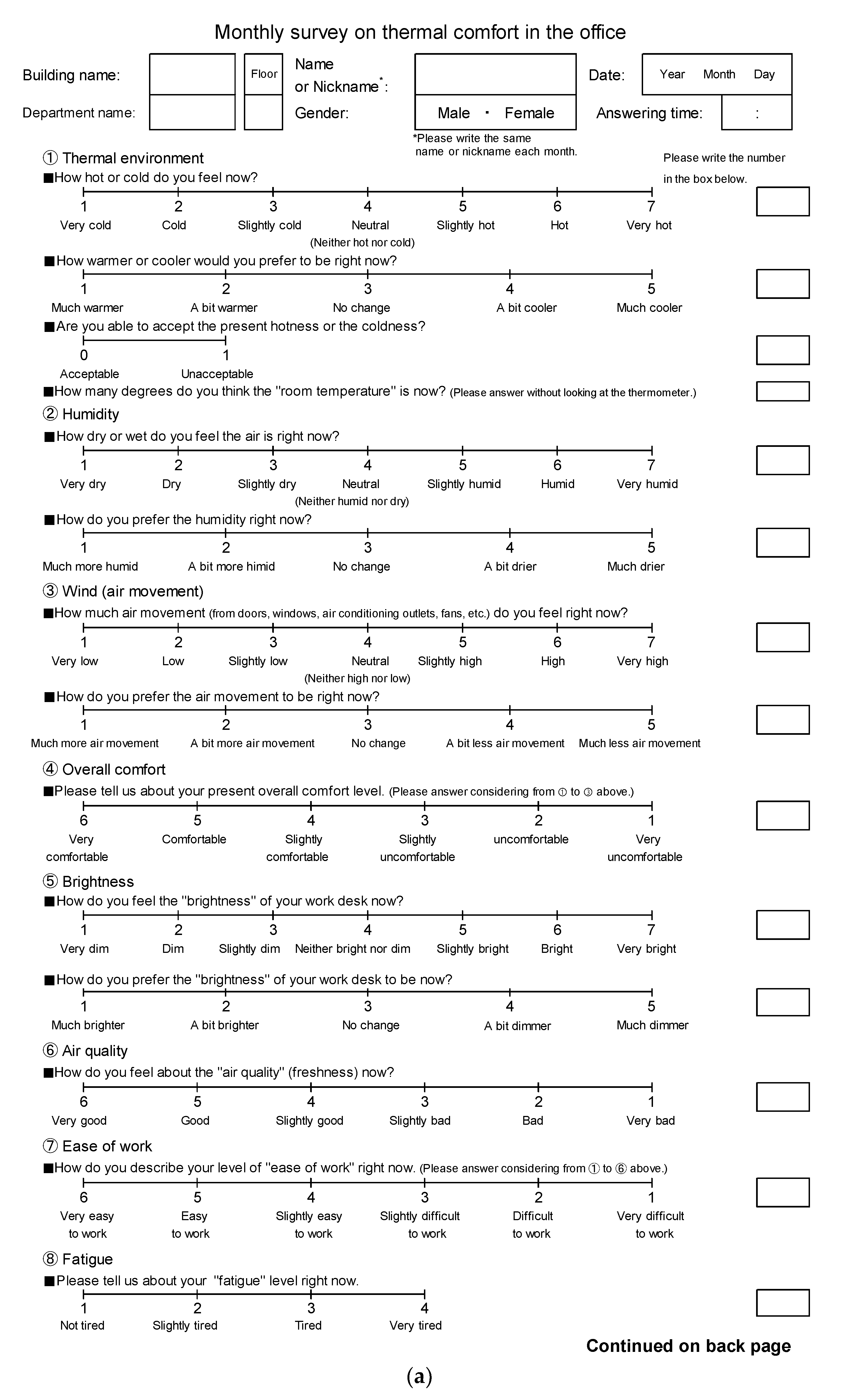
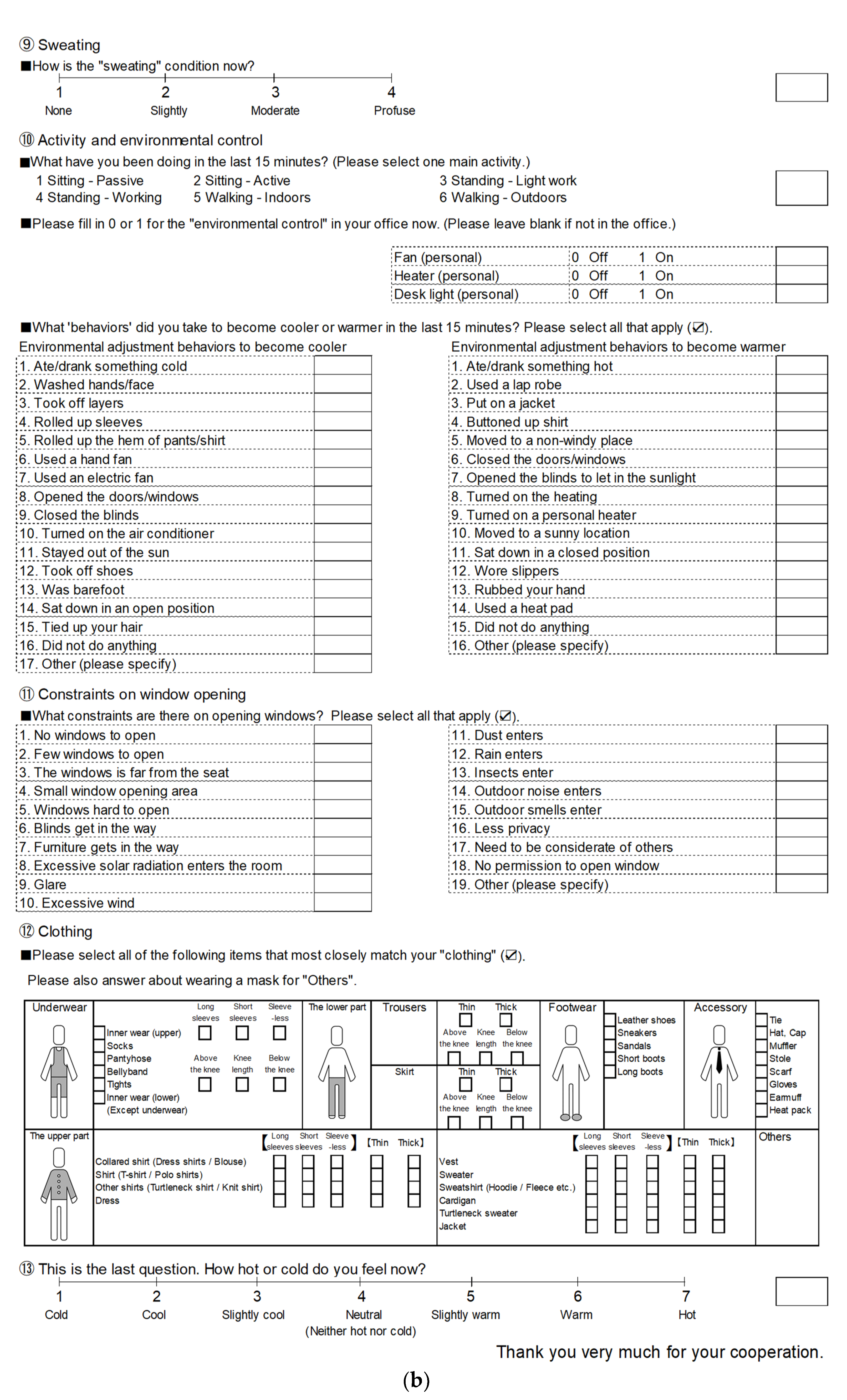
References
- de Dear, R.J.; Brager, G.S. Thermal comfort in naturally ventilated buildings: Revisions to ASHRAE Standard 55. Energy Build. 2002, 34, 549–561. [Google Scholar] [CrossRef]
- Lamsal, P.; Bajracharya, S.B.; Rijal, H.B. A review on adaptive thermal comfort of office building for energy-saving building design. Energies 2023, 16, 1524. [Google Scholar] [CrossRef]
- The Institute of Energy Economics. Handbook of Japan’s & World Energy & Economic Statistics; The Energy Conservation Center: Tokyo, Japan, 2017; ISBN 9784879734648. [Google Scholar]
- Tanabe, S.; Iwahashi, Y.; Tsushima, S.; Nishihara, N. Thermal comfort and productivity in offices under mandatory electricity savings after the Great East Japan earthquake. Arch. Sci. Rev. 2013, 56, 4–13. [Google Scholar] [CrossRef]
- Seppanen, O.; Fisk, W.J.; Faulkner, D. Control of Temperature for Health and Productivity in Offices; Lawrence Berkeley National Laboratory: Berkley, CA, USA, 2004; LBNL-55448. [Google Scholar]
- Tanabe, S.; Haneda, M.; Nishihara, N. Workplace productivity and individual thermal satisfaction. Build. Environ. 2015, 91, 42–50. [Google Scholar] [CrossRef]
- Nakano, J.; Tanabe, S.; Kimura, K. Differences in perception of indoor environment between Japanese and non-Japanese workers. Energy Build. 2002, 34, 615–621. [Google Scholar] [CrossRef]
- Indraganti, M.; Ooka, R.; Rijal, H.B. Thermal comfort in offices in summer: Findings from a field study under the ‘setsuden’ conditions in Tokyo, Japan. Build. Environ. 2013, 61, 114–132. [Google Scholar] [CrossRef]
- Indraganti, M.; Ooka, R.; Rijal, H.B.; Brager, G.S. Adaptive model of thermal comfort for offices in hot and humid climates of India. Build. Environ. 2014, 74, 39–53. [Google Scholar] [CrossRef]
- Dhaka, S.; Mathur, J.; Brager, G. Assessment of thermal environmental conditions and quantification of thermal adaptation in naturally ventilated buildings in composite climate of India. Build. Environ. 2015, 86, 17–28. [Google Scholar] [CrossRef]
- Dhaka, S.; Mathur, J. Quantification of thermal adaptation in air-conditioned buildings of composite climate, India. Build. Environ. 2017, 112, 296–307. [Google Scholar] [CrossRef]
- Singh, M.K.; Ooka, R.; Rijal, H.B.; Takasu, M. Adaptive thermal comfort in the offices of North-East India in autumn season. Build. Environ. 2017, 124, 14–30. [Google Scholar] [CrossRef]
- Thapa, S.; Bansal, A.K.; Panda, G.K. Thermal comfort in naturally ventilated office buildings in cold and cloudy climate of Darjeeling, India—An adaptive approach. Energy Build. 2018, 160, 44–60. [Google Scholar] [CrossRef]
- Manu, S.; Shukla, Y.; Rawal, R.; Thomas, L.E.; de Dear, R. Field studies of thermal comfort across multiple climate zones for the subcontinent: India Model for Adaptive Comfort (IMAC). Build. Environ. 2016, 98, 55–70. [Google Scholar] [CrossRef]
- Damiati, S.A.; Zaki, S.A.; Rijal, H.B.; Wonorahardjo, S. Field study on adaptive thermal comfort in office buildings in Malaysia, Indonesia, Singapore, and Japan during hot and humid season. Build. Environ. 2016, 109, 208–223. [Google Scholar] [CrossRef]
- Karyono, T.H. Report on thermal comfort and building energy studies in Jakarta—Indonesia. Build. Environ. 2000, 35, 77–90. [Google Scholar] [CrossRef]
- de Dear, R.J.; Leow, K.G.; Foo, S.C. Thermal comfort in the humid tropics: Field experiments in air conditioned and naturally ventilated buildings in Singapore. Int. J. Biometeorol. 1991, 34, 259–265. [Google Scholar] [CrossRef]
- Wu, Z.; Li, N.; Wargocki, P.; Peng, J.; Li, J.; Cui, H. Field study on thermal comfort and energy saving potential in 11 split air-conditioned office buildings in Changsha, China. Energy 2019, 182, 471–482. [Google Scholar] [CrossRef]
- Barbadilla-Martín, E.; Lissén, J.M.S.; Martín, J.G.; Aparicio-Ruiz, P.; Brotas, L. Field study on adaptive thermal comfort in mixed mode office buildings in southwestern area of Spain. Build. Environ. 2017, 123, 163–175. [Google Scholar] [CrossRef]
- Rupp, R.F.; de Dear, R.; Ghisi, E. Field study of mixed-mode office buildings in Southern Brazil using an adaptive thermal comfort framework. Energy Build. 2018, 158, 1475–1486. [Google Scholar] [CrossRef]
- Goto, T.; Mitamura, T.; Yoshino, H.; Tamura, A.; Inomata, E. Long-term field survey on thermal adaptation in office buildings in Japan. Build. Environ. 2007, 42, 3944–3954. [Google Scholar] [CrossRef]
- Mustapa, M.S.; Zaki, S.A.; Rijal, H.B.; Hagishima, A.; Ali, M.S. Thermal comfort and occupant adaptive behaviour in Japanese university buildings with free running and cooling mode offices during summer. Build. Environ. 2016, 105, 332–342. [Google Scholar] [CrossRef]
- Rijal, H.B.; Humphreys, M.A.; Nicol, J.F. Towards an adaptive model for thermal comfort in Japanese offices. Build. Res. Inf. 2017, 45, 717–729. [Google Scholar] [CrossRef]
- Takasu, M.; Ooka, R.; Rijal, H.B.; Indraganti, M.; Singh, M.K. Study on adaptive thermal comfort in Japanese offices under various operation modes. Build. Environ. 2017, 118, 273–288. [Google Scholar] [CrossRef]
- Khadka, S.; Rijal, H.B.; Amano, K.; Saito, T.; Imagawa, H.; Uno, T.; Genjo, K.; Takata, H.; Tsuzuki, K.; Nakaya, T.; et al. Study on winter comfort temperature in mixed mode and HVAC office buildings in Japan. Energies 2022, 15, 7331. [Google Scholar] [CrossRef]
- Khadka, S.; Shrestha, M.; Rijal, H.B. Investigation of the thermal comfort and productivity in Japanese mixed-mode office buildings. J. Eng. Res. 2022, 19, 63–72. [Google Scholar] [CrossRef]
- Rijal, H.B.; Humphreys, M.A.; Nicol, J.F. Adaptive approaches to enhancing resilient thermal comfort in Japanese offices. In The Routledge Handbook of Resilient Thermal Comfort; Nicol, J.F., Rijal, H.B., Roaf, S., Eds.; Routledge: London, UK, 2022; Chapter 17; pp. 279–299. ISBN 9781032155975. [Google Scholar]
- Peel, M.C.; Finlayson, B.L.; McMahon, T.A. Updated world map of the Köppen-Geiger climate classification. Hydrol. Earth Syst. Sci. 2007, 11, 1633–1644. [Google Scholar] [CrossRef]
- Japan Meteorological Agency: Historical Weather Data Search. Available online: https://www.data.jma.go.jp/obd/stats/etrn/index.php (accessed on 3 June 2023).
- ISO 7726:1998; Ergonomics of the Thermal Environment—Instruments for Measuring Physical Quantities. International Standardization Organization: Geneva, Switzerland, 1998.
- ANSI/ASHRAE Standard 55-2020; Thermal Environmental Conditions for Human Occupancy. American Society of Heating, Refrigerating and Air-Conditioning Engineers: Atlanta, GA, USA, 2020.
- Imagawa, H.; Rijal, H.B.; Shukuya, M. Development of integrated occupant-behavioural stochastic model including the fan use in Japanese dwellings. Energy Build. 2020, 226, 110326. [Google Scholar] [CrossRef]
- D’Ambrosio Alfano, F.R.; Dell’Isola, M.; Ficco, G.; Palella, B.I.; Riccio, G. Small globes and pocket heat stress meters for WBGT and PHS evaluations. A critical analysis under controlled conditions. Build. Environ. 2022, 226, 109781. [Google Scholar] [CrossRef]
- D’Ambrosio Alfano, F.R.; Dell’Isola, M.; Ficco, G.; Palella, B.I.; Riccio, G. On the measurement of the mean radiant temperature by means of globes: An experimental investigation under black enclosure conditions. Build. Environ. 2021, 193, 107655. [Google Scholar] [CrossRef]
- Spagnolo, J.; de Dear, R. A field study of thermal comfort in outdoor and semi-outdoor environments in subtropical Sydney Australia. Build. Environ. 2021, 38, 721–738. [Google Scholar] [CrossRef]
- Humphreys, M.A. Outdoor temperatures and comfort indoors. Build. Res. Pract. 1978, 6, 92–105. [Google Scholar] [CrossRef]
- Humphreys, M.A.; Rijal, H.B.; Nicol, J.F. Updating the adaptive relation between climate and comfort indoors; New insights and an extended database. Build. Environ. 2013, 63, 40–55. [Google Scholar] [CrossRef]
- McCartney, K.J.; Nicol, J.F. Developing an adaptive control algorithm for Europe. Energy Build. 2002, 34, 623–635. [Google Scholar] [CrossRef]
- Nicol, J.F.; Humphreys, M.A. A stochastic approach to thermal comfort occupant behavior and energy use in buildings. ASHRAE Trans. 2004, 110, 554–568. [Google Scholar]
- Rijal, H.B.; Humphreys, M.A.; Nicol, J.F. Behavioural adaptation for the thermal comfort and energy saving in Japanese offices. J. Inst. Eng. 2019, 15, 14–25. [Google Scholar] [CrossRef]
- Fanger, P.O. ; Thermal Comfort, Analysis and Applications in Environmental Engineering; Danish Technical Press: Copenhagen, Denmark, 1970. [Google Scholar]
- Ayesha, A.; Muhammad, Z.; Khan, S.R.; Sohail, N.F. Investigating the gender differences in indoor thermal comfort perception for summer and winter seasons and comparison of comfort temperature prediction methods. J. Therm. Biol. 2022, 110, 103357. [Google Scholar] [CrossRef]
- CIBSE Guide A: Environmental Design; Chartered Institution of Building Services Engineers: London, UK, 2006.
- CEN-EN16798-1; Energy Performance of Buildings—Ventilation for Buildings—Part 1: Indoor Environmental Input Parameters for Design and Assessment of Energy Performance of Buildings Addressing Indoor Air Quality, Thermal Environment, Lighting and Acoustics—Module M1-6. European Committee for Standardization: Brussels, Belgium, 2019.
- Shahzad, S.; Rijal, H.B. Chapter 20: Mixed mode is better than air-conditioned offices for resilient comfort: Adaptive behaviour and visual thermal landscaping. In Routledge Handbook of Resilient Thermal Comfort; Nicol, F., Rijal, H.B., Roaf, S., Eds.; Routledge: London, UK, 2022; pp. 329–346. ISBN 9781032155975. [Google Scholar]
- Rijal, H.B.; Tuohy, P.; Humphreys, M.A.; Nicol, J.F.; Samuel, A.; Clarke, J. Using results from field surveys to predict the effect of open windows on thermal comfort and energy use in buildings. Energy Build. 2007, 39, 823–836. [Google Scholar] [CrossRef]


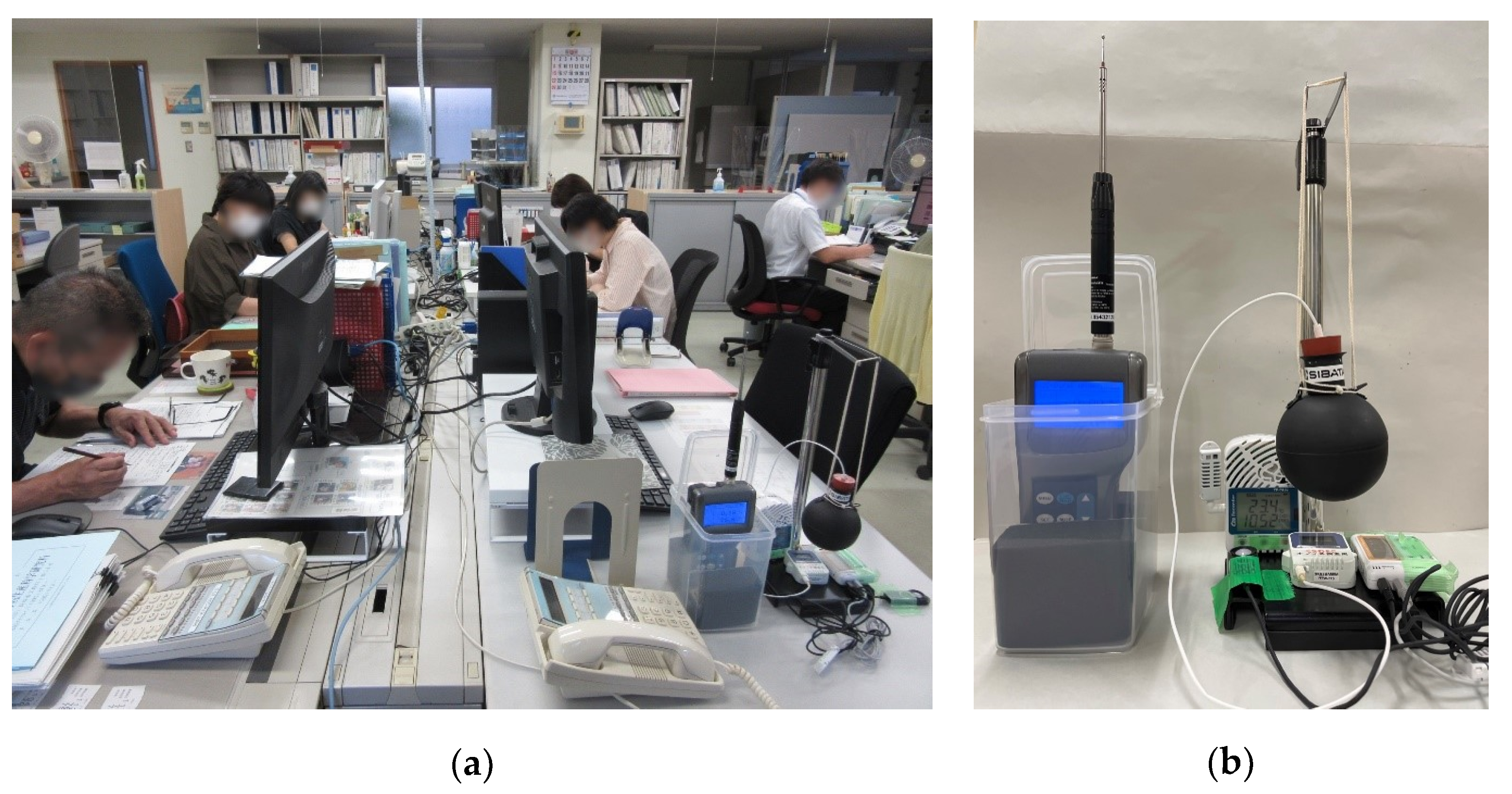

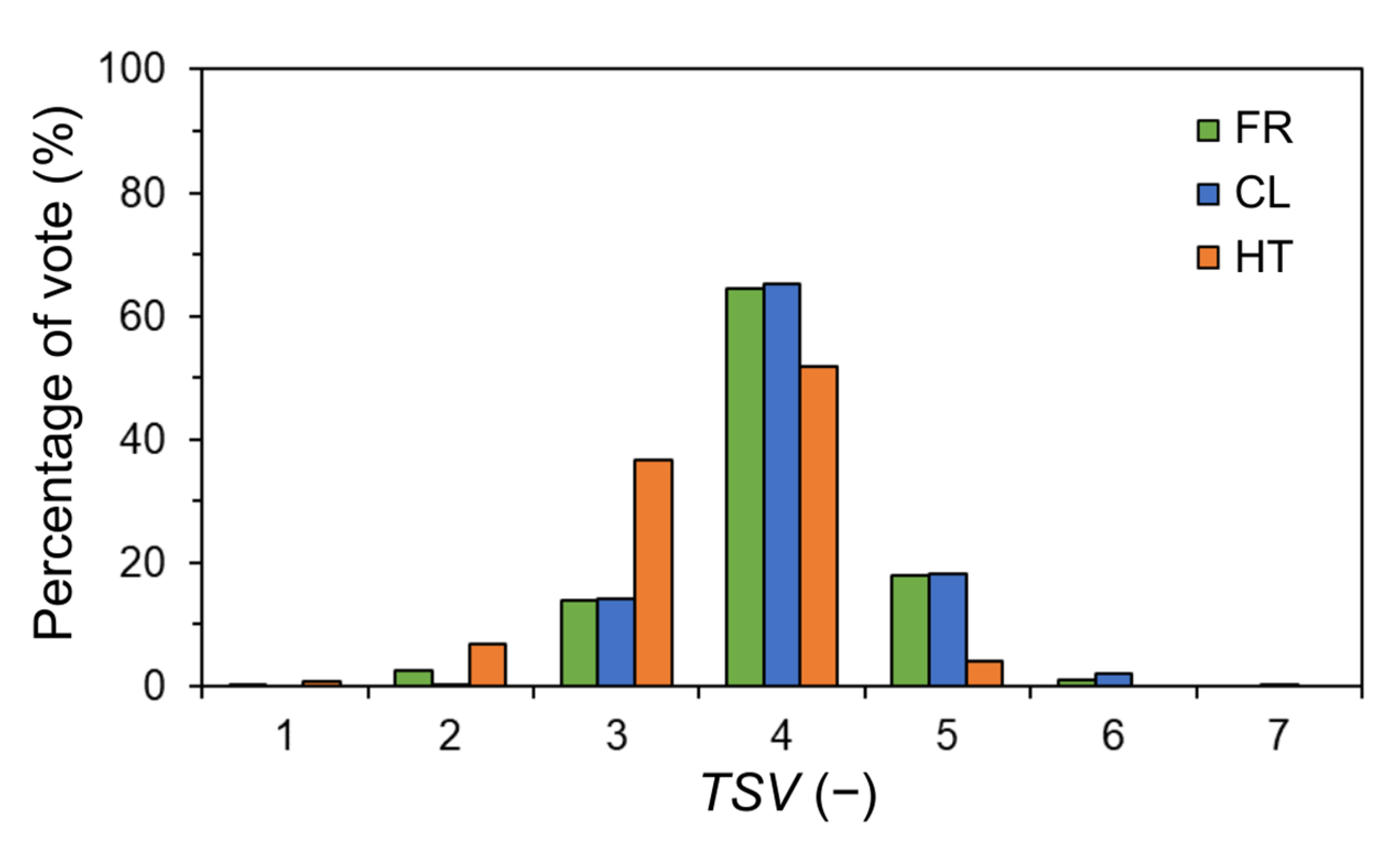




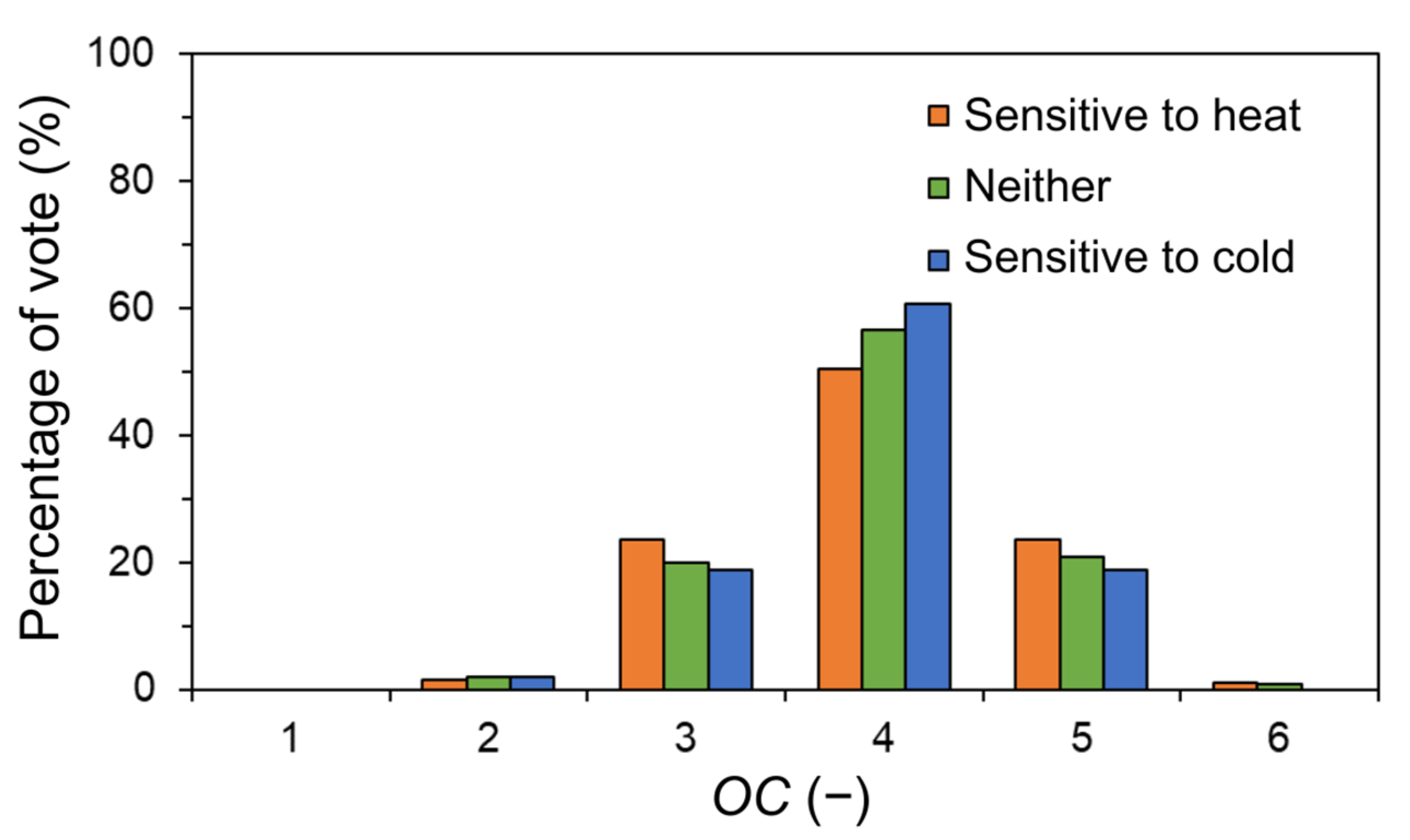

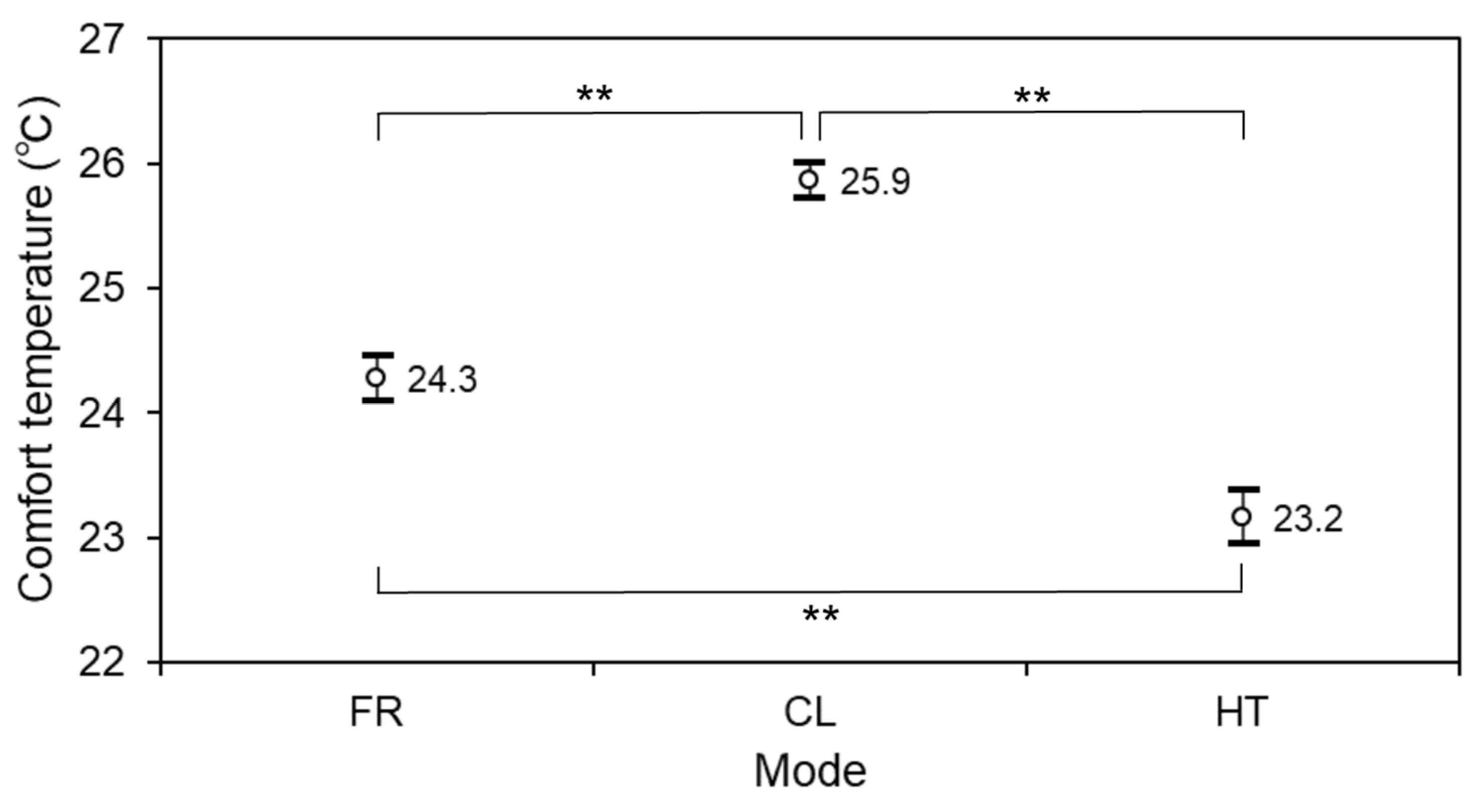
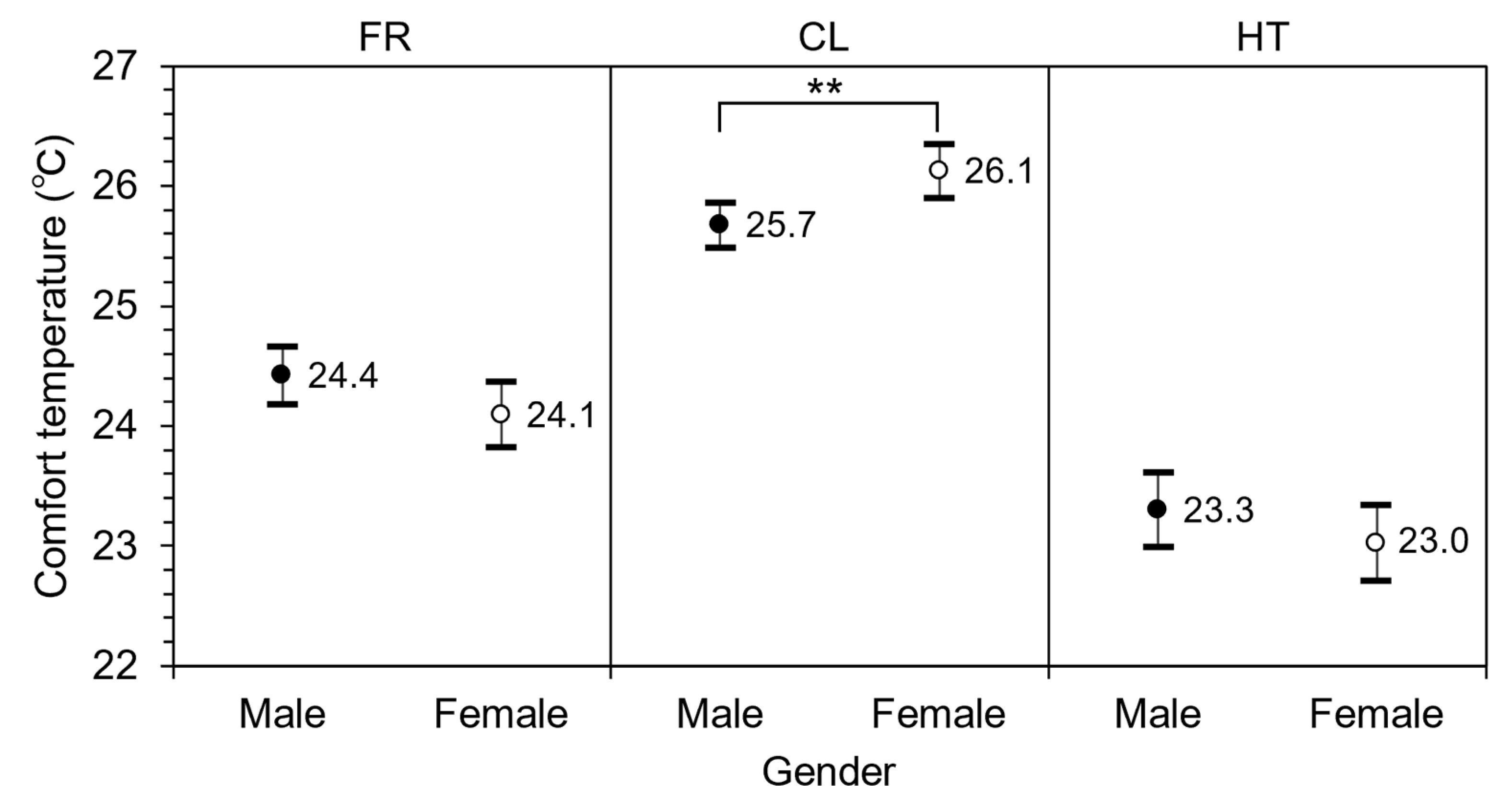
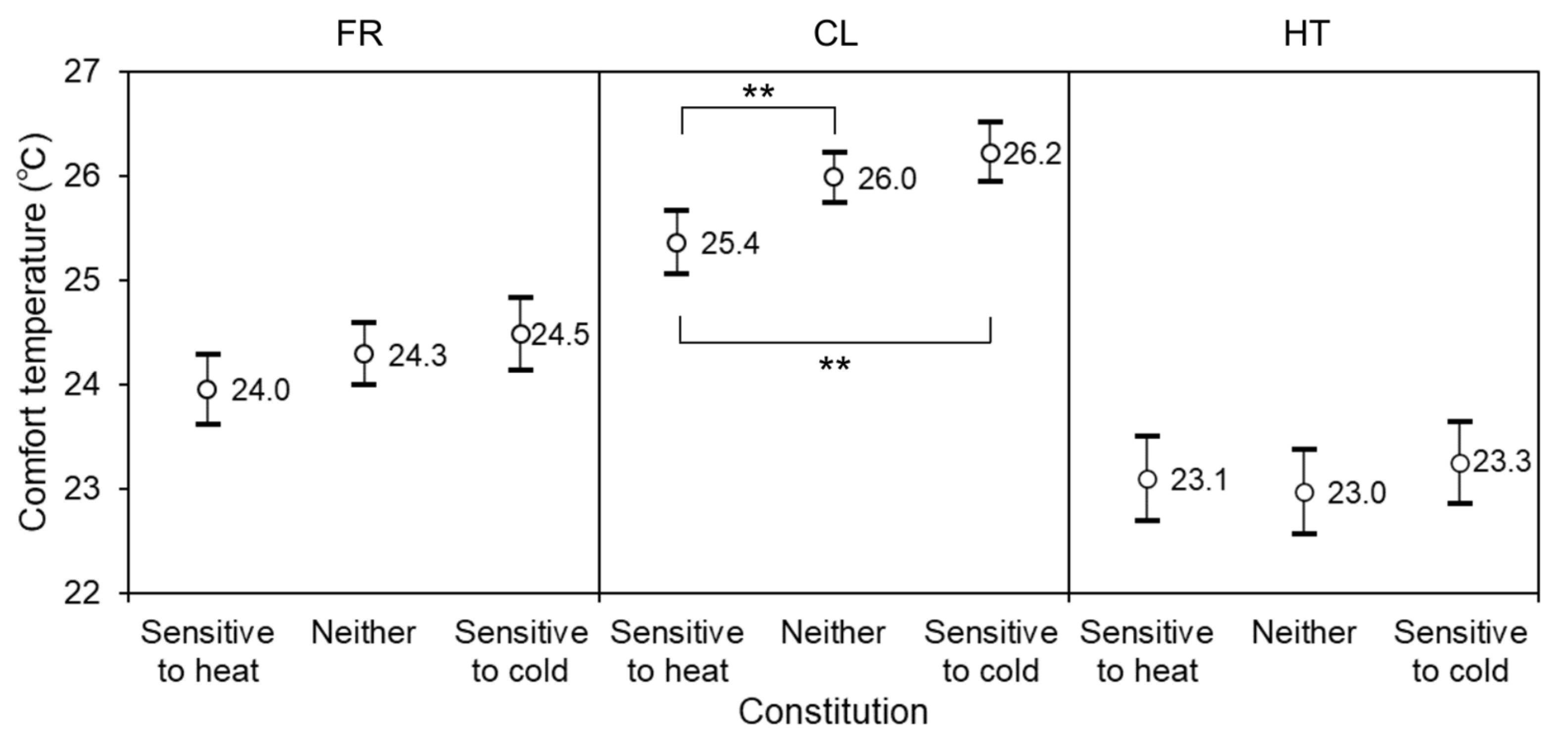



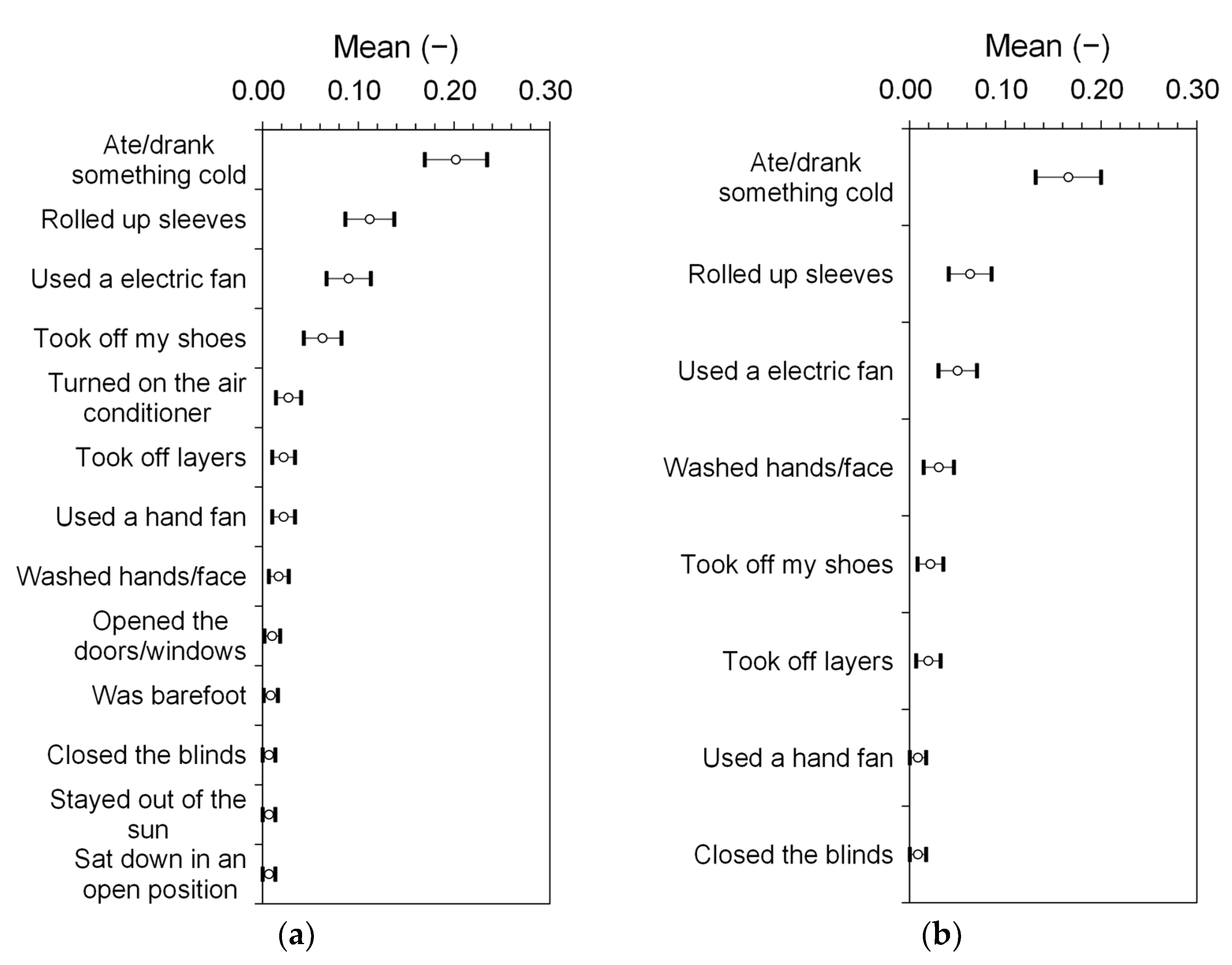
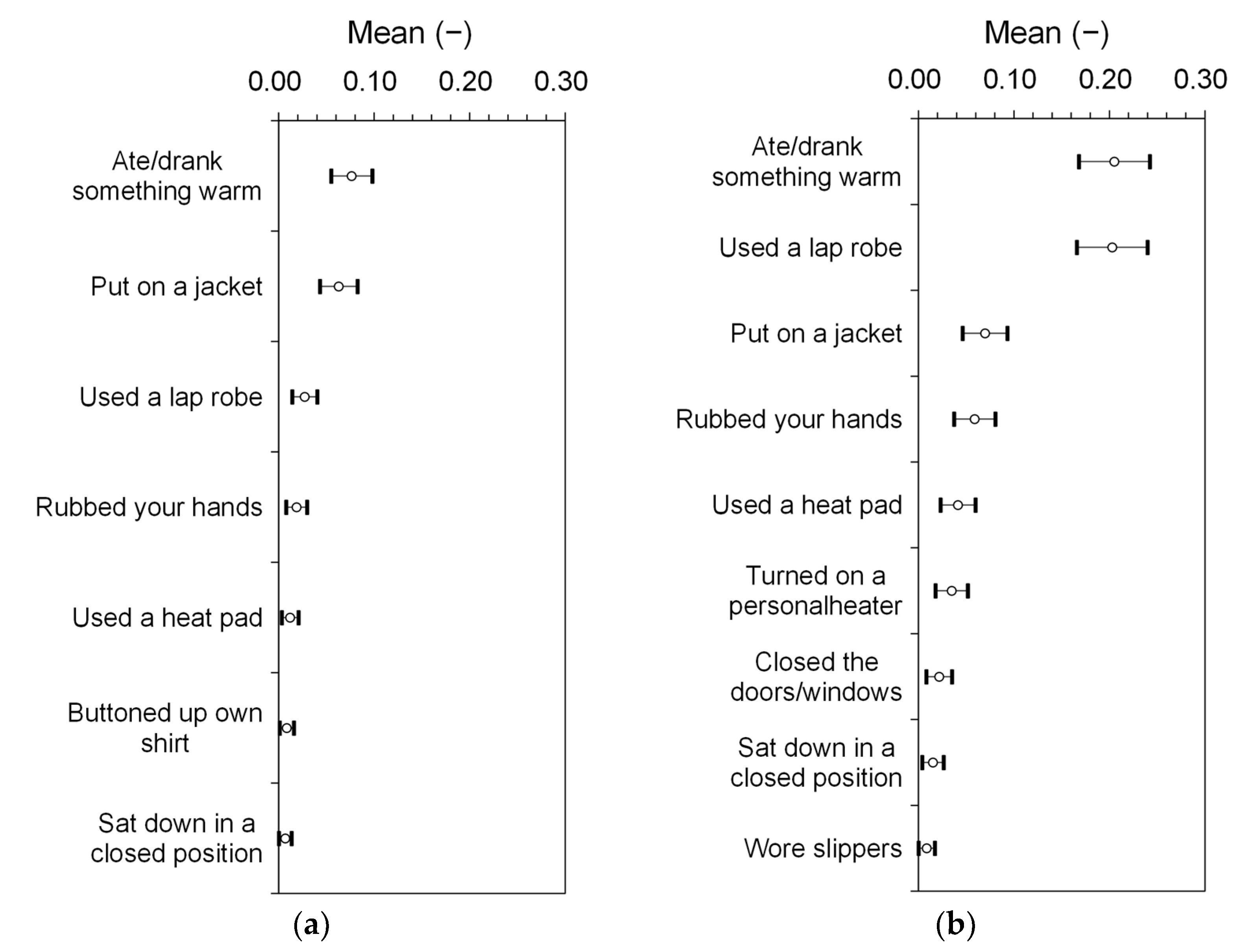
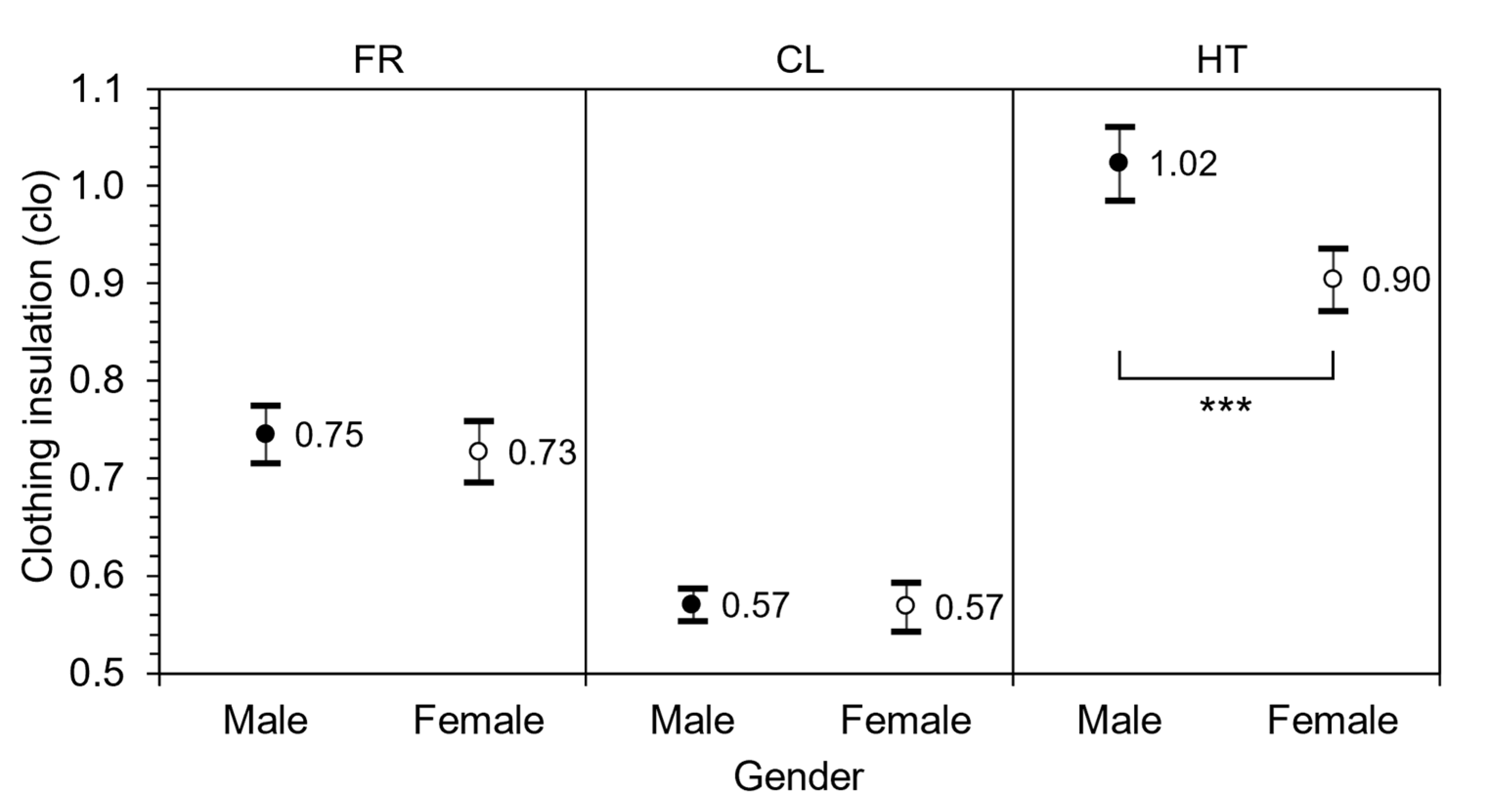
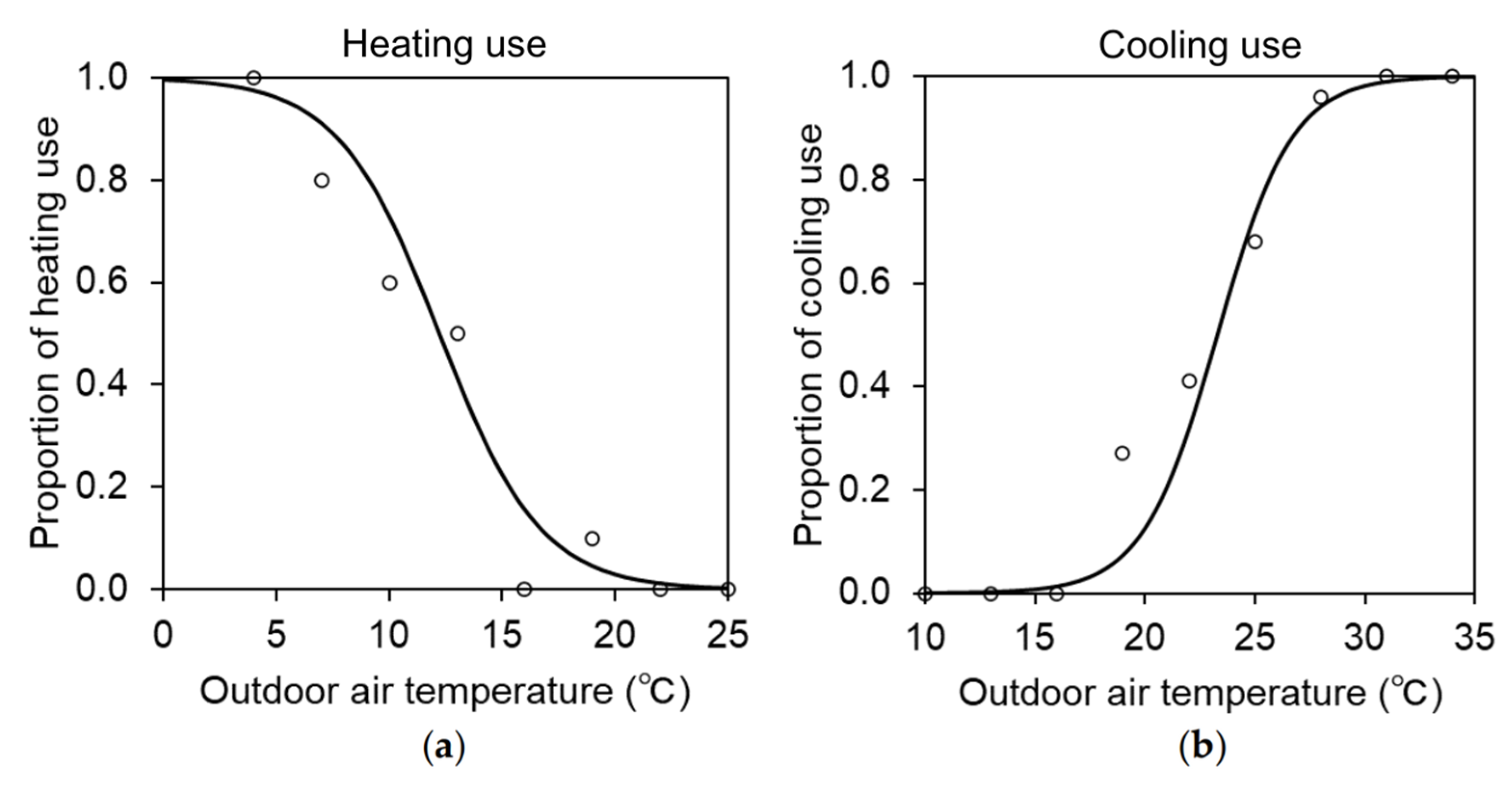

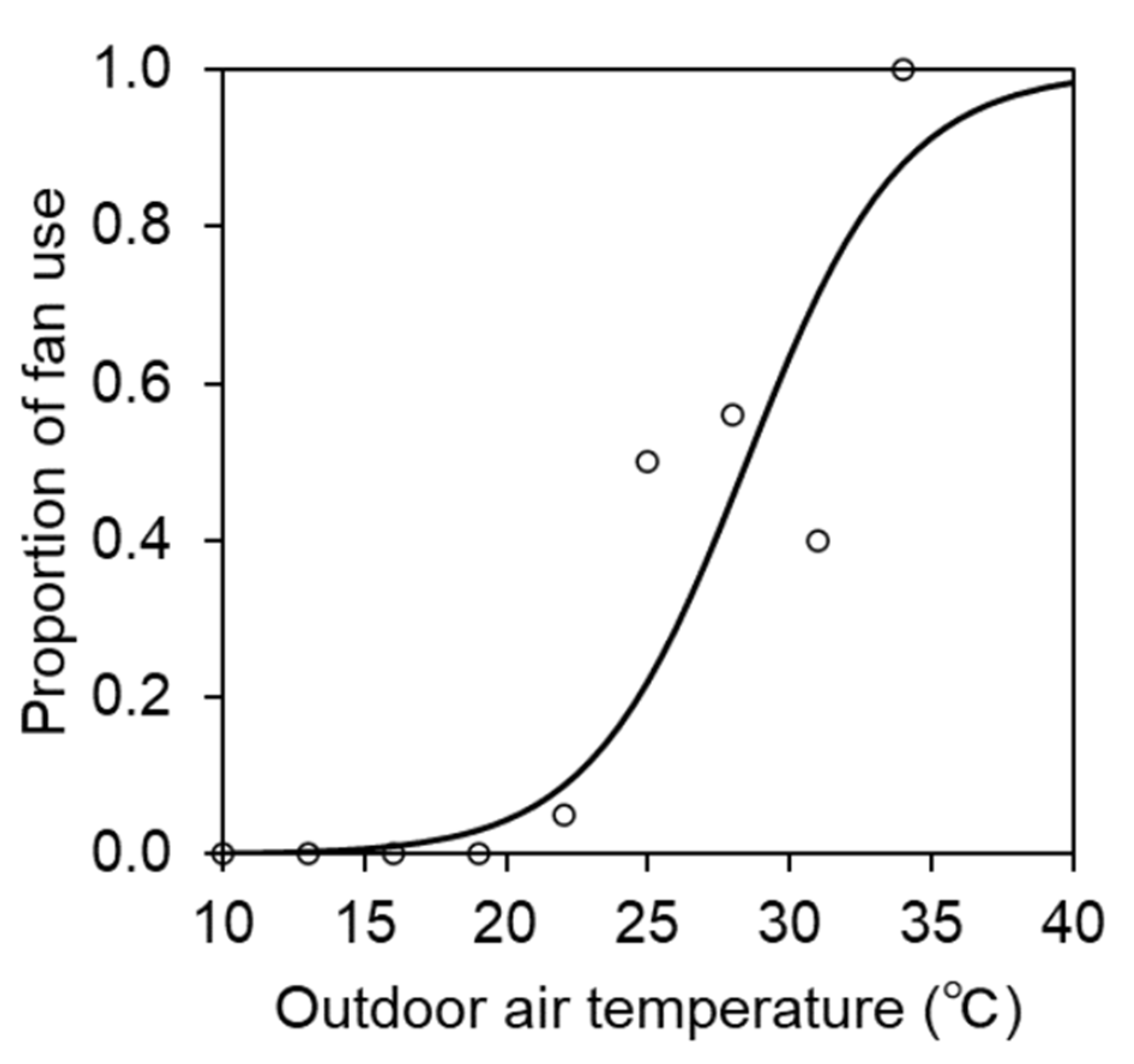
| Country | City Name | References | Number of Buildings | Mode | Survey Period | Variables for Tc | Tg, Ta (°C) | Tc (°C) |
|---|---|---|---|---|---|---|---|---|
| India | Chennai | Indraganti et al. [8] | 13 13 | NV CL | Summer Summer | Tg Tg | 30.1 26.9 | 27.6 *** 27.0 *** |
| Hyderabad | 12 12 | NV CL | Summer Summer | Tg Tg | 29.4 26.0 | 28.1 *** 26.1 *** | ||
| Chennai, Hyderabad | Indraganti et al. [9] | 28 28 | NV CL | Summer Summer | Tg Tg | 28.8 26.2 | 28.0 *** 26.4 *** | |
| Jaipur | Dhaka et al. [10] | 30 | NV | Winter Autumn Summer | Tg Tg Tg | 21.8 29.0 31.9 | 25.6 27.0 29.4 | |
| Jaipur | Dhaka and Mathur [11] | 19 | CL | Summer | Ta | 26.0 | 27.5 | |
| Tezpur, Shillong | Singh et al. [12] | 24 | NV | Autumn | Tg | 27.9 | 27.3 ** | |
| Darjeeling | Thapa et al. [13] | 3 | NV | Summer | Ta | 21.7 | 21.8 *** | |
| Moderate | Ta | 19.3 | 20.5 *** | |||||
| Winter | Ta | 16.3 | 17.6 *** | |||||
| India | Manu et al. [14] | 16 | NV | Summer Winter | Top Top | 29.6 22.8 | 25.7 23.7 | |
| CL HT | Summer Winter | Top Top | 24.7 25.5 | 25.3 25.1 | ||||
| MM FR | Summer Winter | Top Top | 30.2 21.8 | 25.7 23.9 | ||||
| Indonesia | Bandung | Damiati et al. [15] | 3 | FR MM | Summer Summer | Top Top | 26.7 27.1 | 24.7 *** 27.5 *** |
| Jakarta | Karyono [16] | 7 | MM | Summer | Top | 27.2 | 26.7 ** | |
| Singapore | Singapore | Damiati et al. [15] | 2 | CL | Summer | Top | 23.2 | 26.4 *** |
| Singapore | de Dear et al. [17] | 12 | CL | Summer | Top | 22.9 | 24.2 | |
| Malaysia | Kuala Lumpur | Damiati et al. [15] | 4 | CL | Summer | Top | 24.4 | 25.6 *** |
| China | Changsha | Wu et al. [18] | 11 | MM | Summer | Top | 26.9 | 26.7 * |
| Spain | Seville | Barbadilla-Martin et al. [19] | 3 | MM | Summer | Top | 23.5 | 23.6 |
| Brazil | Florianopolis | Rupp et al. [20] | 3 | NV HT | All All | Top Top | 23.4 24.0 | 23.4 *** 24.3 *** |
| City Name | References | Number of Buildings | Mode | Survey Period | Variables for Tc | Tg, Ta (°C) | Tc (°C) |
|---|---|---|---|---|---|---|---|
| Sendai, Tsukuba, and Yokohama | Goto et al. [21] | 6 | FR CL HT | All | SET | 24.7 | 26.0 * |
| Tokyo | Indraganti et al. [8] | 4 | NV CL | Summer Summer | Top Top | 29.4 27.9 | 25.8 *** 27.2 *** |
| Yokohama and Tokyo | Damiati et al. [15] | 4 | FR CL | Autumn Summer | Top Top | 26.5 25.9 | 25.8 *** 25.8 *** |
| Fukuoka | Mustapa et al. [22] | 4 | FR CL | Summer Summer | Tg Tg | 28.1 26.4 | 26.7 *** 26.6 *** |
| Tokyo and Yokohama | Rijal et al. [23] | 11 | FR | Spring Summer Autumn | Tg Tg Tg | 24.5 25.8 24.8 | 24.2 *** 25.7 *** 24.9 *** |
| CL | Spring Summer Autumn | Tg Tg Tg | 25.5 26.0 25.9 | 25.1 *** 25.5 *** 25.4 *** | |||
| HT | Spring Autumn Winter | Tg Tg Tg | 24.3 24.0 23.6 | 24.5 *** 24.2 *** 24.3 *** | |||
| Tokyo and Kanagawa | Takasu et al. [24] | 5 | MM FR | ALL | SET SET | 27.8 27.3 | 25.0 *** 24.3 *** |
| Aichi | Khadka et al. [25] | 7 | MM HVAC | Winter | Ti | 24.5 24.3 | 25.0 *** 24.8 *** |
| Tokyo, Yokohama, and Odawara | Khadka et al. [26] | 17 | MM | Spring Summer Autumn Winter | Tg | 25.0 26.3 24.9 22.7 | 24 ** |
| FR | Spring Summer Autumn Winter | Tg | 25.4 26.1 24.6 22.9 | 23 ** |
| Office | Construction Year | Façades | Orientation of Windows | Percentage of Glazing (%) | Surveyed Floor (Number of Stories) | Number of Responses |
|---|---|---|---|---|---|---|
| B1 | 1966 | Concrete | NE, SE, SW, NW | 33.6 | Fifth (six stories) | 90 |
| B2 | 1967 | Concrete | N, E, S, W | 27.3 | First (six stories) | 223 |
| B3 | 1970 | Concrete | N, E, S, W | 37.7 | Third (third stories) | 290 |
| B4 | 1965 | Brick | NE, SE, SW, NW | 21.7 | Third and fifth (five stories) | 444 |
| Category | Questioned Contents |
|---|---|
| Thermal comfort | Thermal sensation, thermal preference, thermal acceptability, humidity sensation, humidity preference, air movement sensation, overall comfort, and sweat sensation |
| Activity | Activity in the last 15 min |
| Environmental control | Personal fan use, personal heater use |
| Occupant behavior | Environmental adjustment behavior performed by them 15 min before the survey to experience coolness and warmth |
| Clothing | Type, thickness, and length of the clothes (top and bottom) worn and types of underwear, footwear, and accessories worn |
| Scale | Thermal Sensation Vote | Overall Comfort Vote |
|---|---|---|
| 1 | Very cold | Very uncomfortable |
| 2 | Cold | Uncomfortable |
| 3 | Slightly cold | Slightly uncomfortable |
| 4 | Neutral (Neither hot nor cold) | Slightly comfortable |
| 5 | Slightly hot | Comfortable |
| 6 | Hot | Very comfortable |
| 7 | Very hot | − |
| Measurement Item | Measuring Instrument | Accuracy |
|---|---|---|
| Temperature Relative humidity Carbon dioxide concentration | TR-76Ui | ±0.5 °C ±5% ±50 ppm ± 5% of indicated value |
| Globe temperature | RTW-31S Matte black painted 75 mm diameter copper ball | ±0.3 °C |
| Air velocity | Model 6501 Probe (6543-21) | 0.01–0.09 m/s: ±0.02 m/s 1.00–5.00 m/s: ±2% of the indicated value or ±0.02 m/s, whichever is greater |
| Illumination Air temperature Relative humidity | TR-74Ui | Illumination: ±5% Air temperature: ±0.3 °C Relative humidity: ±5% |
| Mode | Total | Gender | Constitution | |||
|---|---|---|---|---|---|---|
| Male | Female | Sensitive to Heat | Neither | Sensitive to Cold | ||
| FR | 398 | 224 | 174 | 98 | 143 | 86 |
| CL | 384 | 226 | 158 | 111 | 122 | 88 |
| HT | 265 | 139 | 126 | 63 | 87 | 72 |
| Mode | Gender | Constitution | |||||
|---|---|---|---|---|---|---|---|
| FR | CL | HT | Male | Female | Sensitive to Heat | Neither | Sensitive to Cold |
| 0.25 ± 0.69 | 0.35 ± 0.58 | –0.04 ± 0.69 | 0.24 ± 0.60 | 0.17 ± 0.75 | 0.20 ± 0.66 | 0.19 ± 0.67 | 0.22 ± 0.71 |
Disclaimer/Publisher’s Note: The statements, opinions and data contained in all publications are solely those of the individual author(s) and contributor(s) and not of MDPI and/or the editor(s). MDPI and/or the editor(s) disclaim responsibility for any injury to people or property resulting from any ideas, methods, instructions or products referred to in the content. |
© 2023 by the authors. Licensee MDPI, Basel, Switzerland. This article is an open access article distributed under the terms and conditions of the Creative Commons Attribution (CC BY) license (https://creativecommons.org/licenses/by/4.0/).
Share and Cite
Genjo, K.; Nakanishi, H.; Oki, M.; Imagawa, H.; Uno, T.; Saito, T.; Takata, H.; Tsuzuki, K.; Nakaya, T.; Nishina, D.; et al. Development of Adaptive Model and Occupant Behavior Model in Four Office Buildings in Nagasaki, Japan. Energies 2023, 16, 6060. https://doi.org/10.3390/en16166060
Genjo K, Nakanishi H, Oki M, Imagawa H, Uno T, Saito T, Takata H, Tsuzuki K, Nakaya T, Nishina D, et al. Development of Adaptive Model and Occupant Behavior Model in Four Office Buildings in Nagasaki, Japan. Energies. 2023; 16(16):6060. https://doi.org/10.3390/en16166060
Chicago/Turabian StyleGenjo, Kahori, Haruna Nakanishi, Momoka Oki, Hikaru Imagawa, Tomoko Uno, Teruyuki Saito, Hiroshi Takata, Kazuyo Tsuzuki, Takashi Nakaya, Daisaku Nishina, and et al. 2023. "Development of Adaptive Model and Occupant Behavior Model in Four Office Buildings in Nagasaki, Japan" Energies 16, no. 16: 6060. https://doi.org/10.3390/en16166060
APA StyleGenjo, K., Nakanishi, H., Oki, M., Imagawa, H., Uno, T., Saito, T., Takata, H., Tsuzuki, K., Nakaya, T., Nishina, D., Hasegawa, K., Mori, T., & Rijal, H. B. (2023). Development of Adaptive Model and Occupant Behavior Model in Four Office Buildings in Nagasaki, Japan. Energies, 16(16), 6060. https://doi.org/10.3390/en16166060









